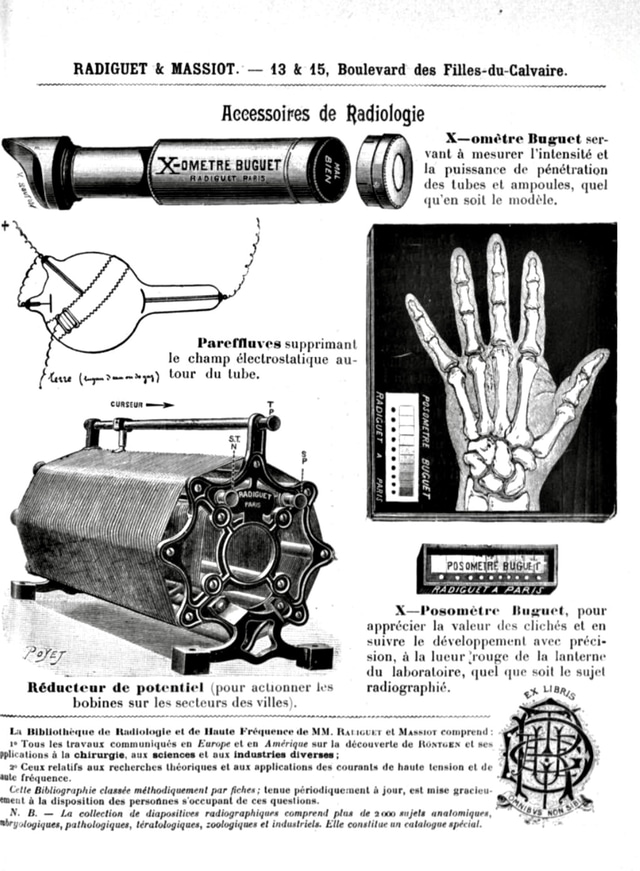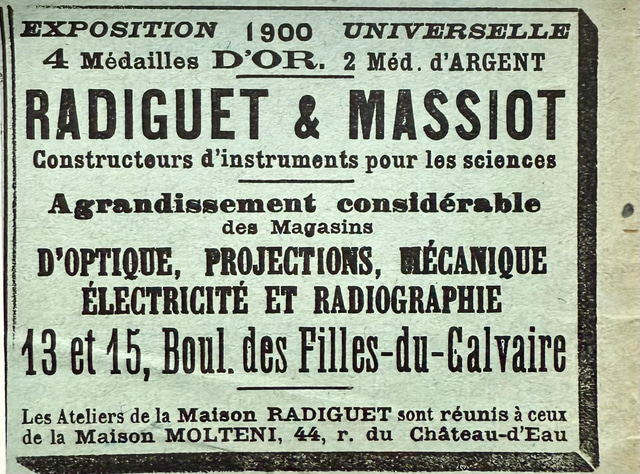

Radiguet, Massiot, and Molteni: A Timeline of Innovation in Projection and Scientific Equipment
H. M. Radiguet began his career as an optician and merchant. He manufactured parallel mirrors and colored glasses for reflective instruments such as circles, sextants, and octants, as well as marine instruments and mirrors for camera obscuras, using a method of his own invention. Radiguet started this production in 1830, although this date may not coincide with the actual foundation of his business. In 1876, his products, including a complete set of parts for miniature steam engines, were showcased at the Philadelphia Exhibition, demonstrating the company's craftsmanship and innovation.
In 1872, H. M. Radiguet, together with his son Arthur-Honoré Radiguet, established the partnership Radiguet & fils, which succeeded the company of Radiguet "père." During this period, they also acquired the business of Molteni, a renowned manufacturer of projection equipment, laying the groundwork for their future success in the field of scientific and educational tools.
In 1899, Arthur-Honoré Radiguet officially merged his company with Molteni and brought his son-in-law, Gaston Massiot, into the management team. This partnership led to the formation of Radiguet & Massiot, specializing in the production of projection devices and scientific instruments. By 1911, the company offered more than 500 different series of "Molteni projections," widely used to illustrate lecture courses.
In addition to projection equipment, the company continued to build on H. M. Radiguet’s legacy of manufacturing miniature steam engines and diversified into new fields such as radio equipment and radiology, becoming a leader in these emerging industries.
After Arthur-Honoré Radiguet's death in 1905, Gaston Massiot took over leadership of the company. In 1910, the firm was renamed Massiot & Cie, marking the beginning of a new era. From 1922, under Massiot’s direction, the company developed devices for projecting opaque objects, such as various forms of epidiascopes. These instruments were primarily intended for medical education but also found applications in judiciary practice and military telegraphy.
Massiot & Cie continued its operations until the mid-1930s, leaving a significant legacy of innovation in projection technologies, scientific instruments, and contributions to fields such as radiology and radio communication. This seamless integration of expertise and adaptation to new scientific demands ensured the company’s lasting influence in the industry.
The Molteni House, founded in 1782 by B. Molteni, manufactured various optical instruments. A. Molteni, the predecessor of the current proprietors, devoted himself in particular to the creation of practical instruments for teaching science through luminous projections. His models are in use in major university institutions in France and abroad (the Sorbonne, the Conservatory of Arts and Crafts, the Museum of Natural History, Lycées, State Schools, etc.).
The collection of glass slides he assembled over more than thirty years has been daily enriched by Radiguet and Massiot, comprising over 60,000 images covering the full scope of human knowledge; they are systematically classified according to educational curricula.
The Radiguet House, since its foundation in 1805, has especially specialized in precision optical glass. In 1872, A. Radiguet established collections of miniature models of mechanical and electrical machines, as well as kits of parts intended for self-assembly by students; these sets were designed for professional training.
The company took part in the discovery of X-rays, manufacturing large induction coils and full equipment for radiology laboratories and high-frequency research, both for scientific investigation and therapeutic applications. Radiguet coils are used in a large number of French and foreign military and civilian hospitals, and have been adopted by the French Navy.
In addition to these specialties, Radiguet and Massiot have also added, thanks to new equipment, a wide range of precision instruments, including large projection microscopes, laryngoscopes, etc.